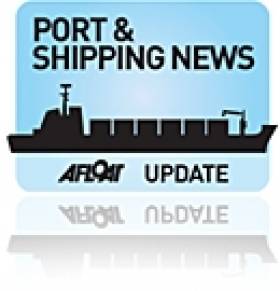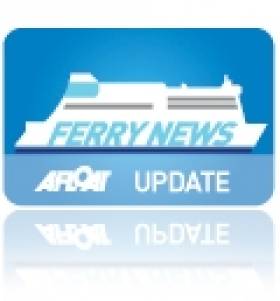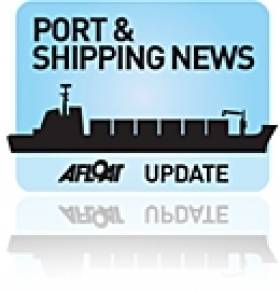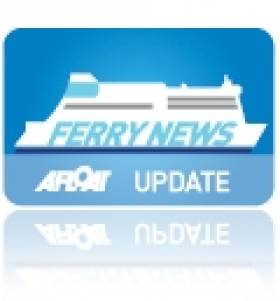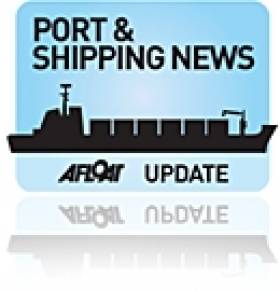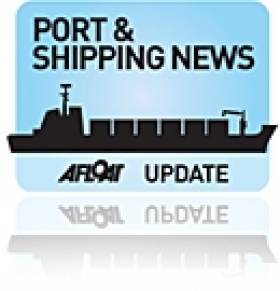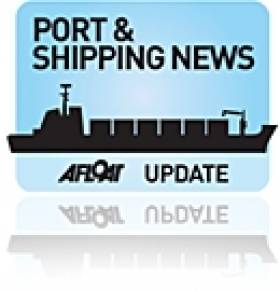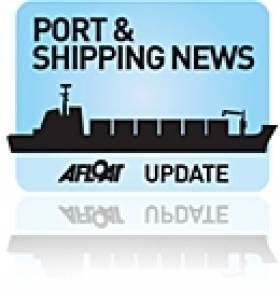Displaying items by tag: Ports & Shipping news
Ports & Shipping Review: Ardmore Name Tankers, Maersk Opt for Suez, Ireland’s Globalised Status, Short-Sea ‘Steady’ and Last Guinness Tanks
#ShippingReview – Over the last fortnight, Jehan Ashmore has reported from the shipping scene, where Cork based Ardmore Shipping named two of their latest newbuild product chemicals tankers at a South Korean shipyard.
According to the IMDO's Weekly Shipping Market Review, Maersk Line, is looking to change its path for the trade lane of Asia to US East Coast, by opting for the Suez Canal as opposed to the current Panama Canal.
In addition the IMDO review reports that Ireland has been ranked the world's third most globalised economy in terms of GDP, and the most globalised nation in the western world, according to Ernst and Young. As for the European Short Sea Market, this has been summarised as "steady/flat", according to HC Shipping & Chartering".
The cargsoship Blue Tune (2010/3,845grt) which currently is docked in Dun Laoghaire Harbour, is understood to have arrived with the final batch of fermentation tanks bound for the Guinness brewery plant in Dublin.
#BrittanyFerries35th – Today Brittany Ferries celebrates launching into its 35th year in operating the Cork-Roscoff seasonal service served by 'flagship' Pont-Aven, writes Jehan Ashmore.
Speaking about the upcoming 2013 season, General Manager of Brittany Ferries, Mr Hugh Bruton said: "This is always a busy time for us as we re-commence our service from Cork to Roscoff. We are delighted to report that the route is currently ahead by 12% on last year which is a great sign for The Gathering!
"It's also an exciting time for the business as we are celebrating our 40th anniversary globally and 35 years of sailing from Cork to Roscoff. Our continued service offers affordable, convenient holidays to France which is perfect for families of all ages".
Pont-Aven, is not just 'any' ferry as at 41,000 tonnes, she has an array of luxurious facilities to include a spa and swimming pool and an on board ambiance of French flair combined with a bilingual crew.
The flagship departs every Saturday from Ringaskiddy Ferry Terminal until November 2013. She offers the shortest and fastest route between Ireland and France, taking 14 hours, several hours shorter than rivals running routes from Rosslare.
The origins of Brittany Ferries can be directly derived to Breton vegetable farmers who wanted to export their produce to markets in the UK following the closure of other west English Channel ferry routes more than forty years ago.
A co-operative of French farmers got to together to form Bretagne-Angleterre Irlande (B.A.I) otherwise as we know today as Brittany Ferries, which started a new service to Plymouth in 1973.
Brittany Ferries soon found demand not just from agricultural exports but in the reverse direction with passengers from the UK which really boosted the fortunes of the company. On foot of this success and within the next few years further routes were added to include its first route to Ireland opened in 1978.
Armorique, Quiberon, Bretagne and Val de Loire are not just nice-sounding names from locations in Brittany and beyond to conjure images and memories of travels past but these placenames were also given to name the ferries that served the route down through the decades.
The route has also brought closer ties through Irish-Gallic history and heritage but also Celtic cultural connections.
For more information on Brittany Ferries 2013 season schedule and more visit www.brittanyferries.ie
#GuinnessTankship - The 86m cargsoship Blue Tune (2010/3,845grt) docked in Dun Laoghaire Harbour last night is undertood to have arrived with the final batch of fermentation tanks bound for the Guinness St. James Gate Brewery in central Dublin, writes Jehan Ashmore.
In heavy seas and strong south-easterly gale force winds, Blue Tune made the short passage across the bay from Dublin Port, having firstly delivered a part-cargo from Rotterdam.
Unlike the previous deliveries of the tanks to Dun Laoghaire Harbour taken on board two Dutch-flagged vessels, firstly by Myrte (2008/6,120grt) in February followed by Keizersborg (1996/6,142grt) last month, on this occasion Blue Tune is flagged under Antigua and Bermuda.
In addition Blue Tune is smaller compared to her Dutch counterparts in terms of tonnage size which would also place her as a 'coaster' compared to much larger vessels calling to Dublin Port and in this recent 'project' cargo trade to Dun Laoghaire Harbour.
As with the other Guinness related cargo-calls, Blue Tune berthed at the former 'mail' boat at Carlisle Pier, where six stainless steel fermentation tanks are due to be unloaded within the next few days.
Likewise forward tank transportation from Dun Laoghaire to the brewery which is undergoing a major €153m upgrade, is to be undertaken by road convoy and expected to be carried out in a night-time operation.
Seatruck Welcomes Heysham Link-Road to ‘Motorway’
#FreightFerry– Irish Sea freight-ferry operator Seatruck Ferries has welcomed the UK government's granting of the Heysham link-road to the M6 motorway, writes Jehan Ashmore.
The new road will improve both the local transport infrastructure and access to the Lancashire port, reduce congestion and cut transport costs.
Work is expected to commence this July and will near completion in late 2015.
Seatruck has been working with other local interests to push for a direct link road to junction 34 of the M6. This will enable easier port traffic access to the motorway network without having to transit through Lancaster.
The origins of Seatruck began in 1996 with the introduction of un-accompanied freight trailer service between Warrenpoint -Heysham, and to specifically meet transportation needs of the haulage industry.
Since then the company has progressed considerably with more routes: Dublin-Liverpool and Dublin-Heysham and a fleet of freight roll-on roll-off ferries.
As previously reported throughout last year on Afloat.ie, Seatruck received a quartet of custom built 'Heysham-Max' new build tonnage delivered from a Germany shipyard.
The final 18,000 tonnes 'P' class newbuild Seatruck Precision entered service last July on the Dublin-Liverpool route.
The company operate more than 50 weekly departures transiting the short-sea network of routes between Ireland and the UK.
Serving this network are freight-ferries with a capacity ranging from 65-150 unaccompanied trailer units.
Some of the 12 strong fleet, are currently deployed on the charter market to other users in the Irish Sea and operating in waters beyond this market sector.
Ardmore Shipping Name Newbuild Tankers
#Shipping-Cork headquartered Ardmore Shipping, has named the two newest vessels to join its fleet, the Ardmore Seavaliant and the Ardmore Seaventure. The pair were built by South Korean company SPP Shipbuilding.
The ceremonies for the 49,999dwt IMO 3 product and chemical tankers took place at SPP's Dukpo and Sacheon shipyards in South Korea.
Ardmore Seavaliant is to start her career with US transportation company, Cargill, on a 12-month charter arrangement. For more on this story, The Motorship reports.
Ports & Shipping Review: Cattleship Reaches Libya, Another Round of Guinness, Duke Visits Dublin, ShortSea '13, New Cork Port Chairman and more…
#ShippingReview – Over the last fortnight, Jehan Ashmore has reported from the shipping scene, where the trade in live-cattler exports to Libya, not seen since the mid-1990's, finally reached conclusion when livestock-carrier Express I docked in Misrata.
The 'ghost' ship Lyubov Orlova, which broke its tow-line in the Atlantic and believed to have possibly sunk, is a sister of the first ever cruiseship caller to Drogheda Port last year.
The Royal Navy's Type 23 Duke Class frigate HMS Richmond (F239) which has a displacement of 4,900 tonnes made a weekend courtesy call to Dublin Port.
A sister of the frigate which featured in a Bond movie starring Pierce Brosnan, by coincidence passed Dalkey on the same day, where the Irish actor was on location for a TV advert.
Next week, on Thursday (14 March), the European Shortsea Conference 2013 is to take place for the first time in France.
A new chairman for the Port of Cork Company, businessman John Mullins has been appointed by Minister of Transport Leo Varadkar.
Another round of Guinness fermentation tanks arrived into Dun Laoghaire Harbour, where Sunday strollers watched as the cargoship Keizersborg (1996/6,142grt) docked at the old 'mail' boat pier.
Commissioners of Irish Lights ILV Granuaile (2000/2,625grt) an aids to navigation tender vessel, is undergoing steel modification works by Arklow Marine Services while berthed in Dublin Port.
The 5 April is the deadline for members of the public to the Department of Transport, regarding plans to merge Bantry Bay Harbour with the Port of Cork Company.
The Irish Continental Group (ICG) parent company of Irish Ferries, have released a statement of results for the year ended 2012.
A new container sea-rail-freight service between Waterford Port (Belview) and Ballina, Co. Mayo began operating to link in with sailing schedules by DFDS Logistics vessels running to Rotterdam.
#SeaRailFreight- A new container rail-freight service between Waterford Port and Ballina began operating this week, to link in with DFDS Logistics sailing schedules to and from Europe.
The container trains are running to a twice weekly service in each direction linking the Belview Port terminal downriver of Waterford City and the northern Co. Mayo town.
According to Irish Rail (Iarnród Éireann), the new service will benefit customers in the west and north-west of Ireland in particular, providing them with a cost effective alternative when compared with a road based shipping. Coupled with this, the customer also reduces their carbon footprint.
The trains are scheduled to meet DFDS lo-lo vessels sailing from Belview Port to Rotterdam, which allows for onward delivery into Europe. Customers can now load in the west of Ireland on Tuesday morning and deliver in The Netherlands on Thursday pm/Friday am.
Rotterdam also provides access to DFDS sailings to Norway, and rail connections to Italy, allowing for a rail-sea-rail connection from Ballina to Milan.
DFDS will utilise a significant amount of available rail-wagons, but have left scope to develop the service further by introducing new customers, both internal Irish traffic and import / export traffic.
This is an important addition to the DFDS services in Ireland, and as a customer for Irish Rail's freight division. The new service is covering a longer distance, guaranteed volumes and direct port access.
The introduction of the service will see freight volumes increase from 91m tonne kilometres in 2012 to 105 m tonne kilometres approximately in 2013.
Irish Continental Group Statement of Results for 2012
#Shipping – The Irish Continental Group (ICG) parent company of Irish Ferries, have released a statement of results for the year ended 2012.
Commenting on the results Chairman John B McGuckian said,''These are resilient results in the face of a challenging economic background. There is now some emerging evidence of an improvement in the Irish economic environment, but we remain cautious, particularly in relation to freight capacity.''
ICG produced another resilient performance in the face of continued economic weakness, which affects both consumer travel and import / export trade flows, the two areas of economic interest for the Group.
During the year the group announced, and completed, the sale of its subsidiary Feederlink. Consequently the results for the group's continuing operations (i.e. excluding Feederlink for both 2012 and 2011) are set out below.
Revenue for the year from continuing operations was up 1.7% at €256.1 million while continuing EBITDA1 was down 3.2%, to €45.8 million, due mainly to lower freight volumes in both Ro-Ro and Lo-Lo and higher fuel costs (up €6.3 million to €53.2 million) largely offset by higher yields in the passenger business.
The net interest charge was €1.8 million (2011: €1.0 million) before a net interest expense from defined benefit pension schemes of €1.6 million (2011: credit of €0.3 million). The taxation charge was €0.5 million compared with €0.8 million in 2011.
The profit on sale of Feederlink was €21.0 million. Basic EPS including the profit on sale of Feederlink was 183.2 cent while adjusted EPS from continuing operations was 104.6 cent, up 3.1%.
For further information of the statement of results, click HERE for PDF download.
IMDO Shipping Review: Irish-Asia Export Growth, Short-Sea Rates Levelling, German Fleet Stalling and much more…
#Ports&Shipping -The latest Weekly Shipping Market Review from the Irish Marine Development Office (IMDO) reports that Asia will be a key trading partner in future Irish export growth according to a report from HSBC Global Connections.
Research from the bank predicts that China will overtake France and Japan to become Ireland's fourth largest export destination by 2030.
In the weekly summary from the Short-Sea Shipping sector, there has been a gradual and steady decline since around the end of October last year, there appears to be signs of rates levelling over the past few weeks, with overall rates remaining stable although pressure remains downwards
Germany's merchant fleet, the third largest in the world, is experiencing stalling growth, as liquidity and capital shortages are taking their toll. The level of tonnage owned and managed by the German fleet is declining for the first time in a decade, according to German Shipowners' association VDR.
The complete IMDO Shipping Markets Review for week 9 is available as a PDF to read or download HERE.
Second Round of Guinness Tanks Arrive
#GuinnessTanks – Another shipment of Guinness fermentation tanks arrived into Dun Laoghaire Harbour, where Sunday strollers watched the cargoship's arrival, from the length of the East Pier, writes Jehan Ashmore.
On this occasion, cargoship Keizersborg (1996/6,142grt) operated by Dutch owners Wagonborg Shipping, berthed at Carlisle Pier. This is the second delivery of the 'project' cargo, with another batch due of the stainless steel cylinders, each weighing 30 tons.
They are bound for St. James's Gate Brewery, where the plant is undergoing a major upgrade costing €153m.
As previously reported, the first shipment was transported on board Myrte (2008/6,120grt) which too had sailed directly from the same Dutch port.
Also in port was the HSS Stena Explorer, which after the cargoship's docking, departed for Holyhead, so to complete the return leg of the daily operated single round-trip service.


























